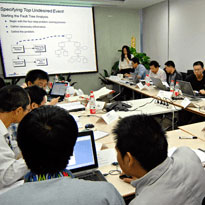5G Layers 1-3 with Emphasis on e-CPRI
- Course:5G Layers 1-3 with Emphasis on e-CPRI
- Course ID:5G3LECPRI Duration:5 days Where: Your Office (7+ Persons)
- Download Course Description (PDF)
Available as a private, customized course for your group at your offices or ours and in some cases as a WebLive(TM) class.
Course Outline
5G Layers 1-3 with Emphasis on e-CPRI
5G Layers 1-3 with Emphasis on e-CPRI: Day 1
- 5G Radio: An Introduction
- 5G Spectrum & Frequency Bands
- Sub-6GHz, cmW, mmW
- Spectrum Management & Spectrum Sharing
- UE 5G NR Radio Requirements
- 5G requirements for RAN: Bandwidth, power, spectral efficiency, new technology adaptation, latency, signaling load, capacity, coverage, interference, mobility
- 5G requirements for Core: Network topology, cloud architectures, big data analytics
- Base Station 5G NR Radio Requirements
- Common UE and BS Radio Requirements
- 5G NSA and SA architectures
- 5G core and 5G-EPC brief overview
- 5G: New Radio (NR) Physical Layer
- How 5G will differ from 4G
- NR channel structure
- Relation to LTE
- NR time (slot) and frequency (SCS & RB) structure
- The new concept of bandwidth part (BWP) and how it is configured/controlled by operator
- Why flexible numerology?
- The L1 processing chain
- OFDM principles (basic introduction, FFT and signal generation)
- OFDM signal processing (up sampling, decimation)
- Modulation Schemes (256QAM, 64QAM, 16QAM, QPSK) and evolution from IQ modulator – IQ imbalance, phase errors, DC offset errors
- L1 Time synchronization, frequency synchronization
- L1 FEC and LDPC coding and decoding – analysis on decoding performance
- Code Block Group (CBG) based retransmissions
- L1 CRC coding and decoding – the BLER concept
- L1 rate matching
- The BBU modular architecture (ADC, DAC, Scheduler module, Link Adaptation module, Power control module, MIMO precoder module)
- The mMIMO antenna panel modular RF chain structure (PA, LNA)
- The RF traditional (Radio Remote Unite or RF card) chain modular structure (PA, LNA)
- BBU calibration requirements
- RRU calibration requirements
- OFDM signal processing (up sampling, decimation)
5G Layers 1-3 with Emphasis on e-CPRI: Days 2-3
- 5G 3GPP Physical Layer Channels, Signals and Procedures
- 3GPP Physical layer procedures for control signaling
- Synchronization signals and reference signals structure
- Cell search procedure
- SS/PBCH structure
- Random access preamble formats – initial beam establishment
- Downlink control signaling
- Uplink control signaling
- Overview power control
- Overview transmit timing control
- 3GPP Physical procedures for user data transmissions
- Reference signals (DMRS, CSI-RS, TRS, PTRS, SRS)
- 5G Layer 2 Procedures
- Explain the L2 transport protocols SDAP, PDCP, RLC, MAC and GTP-U Protocols
- Describe the contents of the SDAP, PDCP, RLC and MAC Packet Data Unit
- Describe the SDAP functions in the user plane
- Explain the PDCP functions
- Explain the RLC functions
- Explain RLC transparent, unacknowledged and acknowledged modes
- Explain the MAC functions
- MAC HARQ codebook principles
- Scheduler functionality for UL and DL
- Scheduler resource allocation (time-frequency grid)
- How scheduler controls physical layer resources
- RACH analysis
- Scheduling requests, BSR, CQI/CSI reports
- Beam management functions
- P1, P2, P3 algorithm implementations
- Explain the main functions & procedures of the transport protocol GTP-U
- Traces and signaling examples
5G Layers 1-3 with Emphasis on e-CPRI: Days 3-4
- 5G Layer 3 Procedures
- Explain the interaction between Radio Resource Control (RRC) and the lower layers in the control plane
- Distinguish the RRC connected, inactive and idle UE states
- Detail the functions and services of RRC
- Explain the RRC signaling flow for SA service connectivity
- Explain the RRC signaling flow for NSA service connectivity
- Carrier aggregation
- Emphasize on SIB contents and accessibility procedures
- List the main functions and procedures of XnAP signaling protocol
- List the main functions and procedures of NGAP signaling protocol
- NAS signaling
- NAS contents in MME/AMF
- Paging procedure
- Traces and signaling examples
- 5G Mobility
- Explain Mobility and Dual Connectivity in 5G
- Describe Inactive and Idle mode mobility in Standalone and Non-Standalone NR
- SSB control and scheduling
- UE synchronization
- Detail the bearer type transitions (MN terminated MCG <-> SN terminated split DRB) in Non-Standalone NR
- Describe the user plane control transitions
- Explain Dual Connectivity mobility
- Explain connected mode mobility in Standalone NR
- Mobility analysis and examples
5G Layers 1-3 with Emphasis on e-CPRI: Day 5
- 5G MIMO – Beam forming
- Massive MIMO general introduction
- Beamforming and spatial multiplexing principles
- MAC layer to mMIMO antenna panel interaction
- Describe how scheduler schedule data on mMIMO antenna panel and the creation of the beams
- MIMO/Beamforming modules
- Codebook vs non-codebook transmissions
- The new concept of Grid of Beams (GoB)
- Analog vs. digital beamforming
- e-CPRI standards and description
5G Layers 1-3 with Emphasis on e-CPRI : Course Wrap-up
Course in a Nutshell
5G Layers 1-3 with Emphasis on e-CPRI explores the lower layer 2, upper layer 2, and layer 3 protocols and procedures for radio technology involved in 5G RAN New Radio (NR), the e-CPRI and MIMO, and the MIMO/Beamforming techniques.
Customize It
The duration and content of 5G Layers 1-3 with Emphasis on e-CPRI can be customized to your participants’ backgrounds and needs.
Aimed At
This 5G Layers 1-3 with Emphasis on e-CPRI course is for those who need to understand 5G protocols to aid their network implementation from 3GPP to oRAN.
Prerequisites
Those wishing to take 5G Layers 1-3 with Emphasis on e-CPRI should have a good understanding of LTE/LTE-A and wireless communications.

